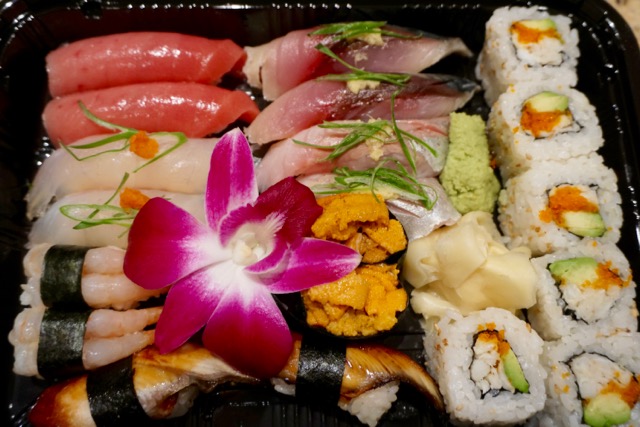After my wife had sushi made with tuna salad ツナサラダ (canned tuna dressed in mayo) in Japan, she was convinced that mayo and sushi rice are a good combination. We tried hand rolls of sashimi tuna dressed in mayonnaise which was quite good. I also made "imitation" negi-toro 擬制ネギトロ from low quality frozen yellow tail tuna using mayonnaise. I then made a "donburi" with it ネギトロ丼 which was also very good. One evening, my wife, all of the sudden, asked me to make sushi out of my salmon salad as an ending dish. I often make salmon salad from leftover salmon after we have a salmon dinner. The version of salmon salad we had was made from flaked cooked salmon, chopped sweet onion, celery, and fresh dill dressed with mayo, Dijon mustard and the Greek yogurt my wife makes. We usually eat this as a sandwich or a canapé. I complied with her request and made salmon salad sushi.
I garnished it with thin slices of cucumber.
I made it in "Gunkan" 軍艦 or battle ship style. I just used our frozen rice which I microwaved and then dressed with sushi vinegar. This is not the best sushi I have ever had but it was certainly quick and more than just edible.
Having this dish, further confirmed my wife's belief that sushi rice and mayo are an excellent match, and I have to agree. This was an impromptu "shime" 〆 ending dish and it was quite good. Now, she is lobbying me to make "egg salad" sushi, we will have to see.
Showing posts with label sushi. Show all posts
Showing posts with label sushi. Show all posts
Friday, February 17, 2017
Thursday, November 17, 2016
Kelp-cured salmon molded sushi 鮭の昆布締め押し寿司
The day we received sashimi-grade salmon, I made instant gravlax for lunch. While I was preparing the gravlax, I also prepared "kelp cured salmon" 鮭の昆布締め. Usually, white meat fish is used for this preparation but I wanted to experiment. After almost 3 days curing, I made molded sushi or "Oshizushi" 押し寿司 out of it. I served it with French style green beans dressed with sesame dressing インゲンの胡麻和え and simmered burdock root ごぼうのしぐれ煮. I also served my potato salad topped with salmon roe soaked in sake and soy sauce イクラの醤油漬け. I served miso soup with tofu, and onion on the side.
Actually one mold made 7 pieces. Since it was an uneven number, but wife and I split one before plating. I garnished it with fresh dill. You cannot see it well but I made two layers of sushi rice; one seasoned with dried "aonori" seaweed 青のり and the other with red perilla salt or "Yokari" ゆかり(see #6 in the composite picture below).
Kelp cured salmon
Ingredients:
Sashimi-grade salmon, thinly sliced (#1).
Dried Konbu kelp, briefly hydrated until pliable, moisture blotted (three 4 inch pieces of kelp).
Directions:
I placed the slices of salmon on the kelp (#2) and covered them with another piece of kelp. I added one more layer of salmon slices and topped with more kelp.
I wrapped the kelp and salmon in aluminum foil and placed the package in the refrigerator.
I cured it for 3 days.
Kelp cured salmon molded sushi
Ingredients:
Kelp cured salmon slices
Sushi rice
Dried "aonori" powder
Yukari (powder of dried red perilla leaves mixed with salt)
Directions:
I soaked the wooden mold in water for 10-15 minutes. I placed one layer of the kelp-cured salmon slices on the bottom of the mold (#3).
I divided the sushi rice into two portions; I mixed one with dried "aonori" seaweed and the other with Yukari powder making green and red colored rice.
I first placed the aonori rice in the mold over the salmon piece and pressed using the wooden lid of the mold. I then layered the Yukari rice on the top (#4) and pressed using the wooden lid.
I cut the molded portion into 7 pieces (#5).
As you can see the rice layers are green and red (#6)
Since I had potato salad which I made a few days ago and "ikura" salmon roe which I marinated in a mixture of sake and soy sauce, I made the dish below (I put the potato salad in a round mold and topped it with the salmon roe)
With the combination of side vegetables, potato salad and miso soup, we were quite full. Compared to kelp-cured white fish, the salmon has too strong a flavor and is too oily to have a lot of kelp umani flavor transferred to the fish. But still we could taste the subtle difference between straight raw salmon and this preparation of salmon. The combination of aonori and yukari rice was a great success and the saltiness of yukari rice and nori flavor really added to this dish.
Monday, November 14, 2016
Philly and Tekka rolls フィラデルフィア巻き、鉄火巻き
We received tuna, salmon and uni from Catalina on Saturday morning. For Sunday lunch, I made one of the American-invented rolls called Philadelphia roll (or Philly roll for short). I also made the more traditional tuna "tekka" roll. I made Philly roll as a medium sized roll or "chumaki" 中巻き (left in the picture below) and tuna roll as a "hosomaki" 細巻き (right).
Philly roll is so named because it is made with Philadelphia cream cheese.* It also included salmon and cucumber. The salmon and cream cheese combination is, of course, the traditional match used for Salmon Lox and cream cheese on a bagel; a classic (New York) Jewish breakfast. Philly roll can be "Uramaki" 裏巻き, (rice outside and nori inside) or "Omotemaki" 表巻き (Nori outside and rice inside). I decided to make it "Chumaki and omotemaki".
*Cream cheese may have the origin in Europe but is usually considered an American cheese. Philadelphia brand became the most popular version of this cheese which is now a part of Kraft Foods.
I served it with miso soup made of wakame seaweed, tofu and scallion.
Ingredients (for one medium roll):
Sushi rice, about one cup (#1, picture is the amount of rice for one medium Philly roll and one small tuna roll),
Sheet of nori (#2)
Cream cheese, cut into sticks (#4)
Salmon, sushi grade, cut into sticks
Cucumber (American mini cucumber), cut into quarters lengthwise with center soft part with seeds removed.
Wasabi
Directions:
To make sushi rice, I mixed seasoned rice vinegar (with sugar and salt or from the bottle) and let it sit for 10-15 minutes loosely covered with a tea towel (to lower the temperature of rice and let the rice absorb the vinegar, #1).
I placed a full sheet of nori with shiny side down on the sushi mat (#2).
I spread the rice in thin layers making sure to leave about half an inch of uncovered edge of nori on the far side (moisten your hands with water with a splash of rice vinegar in it, #3).
I smeared the wasabi in a horizontal line on the nori using a finger. The line was approximately where the contents of the roll would be placed.
I put the salmon, cream cheese and cucumber on the side close to me (#4).
I rolled the mat with the nori/rice on it to make sure the edges of the nori sheet overlaped. I then squeezed the mat with the roll in it to make a firm roll (#5).
I also made a small roll with tuna in the center using a half sheet of nori (#6).
This does not look like a lot of sushi but we were quite full after eating this. My wife likes miso soup for lunch. This was a good starter after we received the sashimi items. Our expectations for a dinner of the other sashimi items we had received grew after enjoying this lunch.
Tuesday, April 12, 2016
Sushi Burittos from Buredo 寿司ブリト
Sushi is very popular in US and can be found just about everywhere. But there is a wide range in quality and price; from "super market" sushi to "omakase". In addition sushi is undergoing a trans-formative evolution at the hands of this popularity. Unique sometimes outlandish, by traditional Japanese standards, sushi rolls have appeared and are extremely popular in sushi bars. Of course there is the grandfather of western-invented rolls, the California roll カルフォルニア巻き made with real or imitation crabmeat and avocado. Although not a native of Japan, it has apparently found a foothold and I hear that it is now generally available in sushi bars. (Although probably not in expensive traditional places). Recently I read some interesting articles in the Washington Post regarding something called sushi burritos. It is a variation of burrito that is like a thick sushi roll that has not been cut into slices. It uses nori sheets with a thin layer of rice instead of a tortilla to hold together the ingredients rolled up in it. It is apparently taking off in a big way. One particular restaurant specializing in sushi burritos just opened. It is called "Buredo" which was created and run by two Washingtonians as a healthy lunch alternative. I don't think I would have gone there on my own to have a sushi burrito but a recent surprise party (I was completely caught by surprise) at work was catered from Buredo and gave me an opportunity to try out a sushi burrito.
This is what I had.

Since it was not sliced, it was a bit difficult to bite through the nori but the fish was quite fresh. The sauce was a bit on the sweet side. Despite the ethnic fusion/confusion involved they were pretty good. I can see why they are getting to be popular. At the same time I have to shake my head and wonder 'what is the world coming to? Is nothing sacred any more?' Then I wonder if the sushi burrito will make its way to Japan soon and what kind of transformations it will undergo there. If it does I'll have to try it out.
It was quite a spread with all their regular menu represented. The picture below shows two different kinds; one is tuna and the other is vegetarian with tofu. The descriptions below are from their menu.
Hanzo (left 3 of the bottom and the second rows)
bright, fresh: yellowfin tuna sashimi, avocado, cucumber, pickled fennel, arugula, tempura crunch, lemon aioli.
Elle (right two on the 1 st and second rows and the rest of the rolls)
savory, sweet: organic tofu, arugula, roasted red pepper, jicama, green onion, black sesame seeds, garlic crunch, passionfruit miso sauce.
Pai Mei
smoky, creamy: salmon sashimi, asparagus, pea shoot leaves, pickled red onion, daikon, katsuo mirin crunch, toasted sesame mayo.
This is what I had.
Beatrix
umami, sweet: yellowfin tuna and salmon sashimi, cucumber, pickled cabbage, green onion, tempura crunch, unagi sauce.

Since it was not sliced, it was a bit difficult to bite through the nori but the fish was quite fresh. The sauce was a bit on the sweet side. Despite the ethnic fusion/confusion involved they were pretty good. I can see why they are getting to be popular. At the same time I have to shake my head and wonder 'what is the world coming to? Is nothing sacred any more?' Then I wonder if the sushi burrito will make its way to Japan soon and what kind of transformations it will undergo there. If it does I'll have to try it out.
Thursday, March 17, 2016
Take-out Sushi omakase from Tako Grill お任せテイクアウト寿司
This was Saturday and I realized I left my credit card at Tako Grill when we visited earlier in the week. I was working that Saturday and stopped by at Tako Grill on the way home to pick up the credit card. We would have gone to Tako Grill for the evening enjoyment using the credit card incident as an excuse but, since I was still working and could not drink, we decide to have take-out sushi. We just cannot enjoy sashimi or other goodies without sake. Both Sushi Chefs, Jose and Santos, were there behind the counter. So, instead of choosing from the menu, I left it up to them. They know what we like. The below was what we got. The California rolls were made with real lump crab meat not imitation with additional tobiko as we always order. It was even garnished with an orchid flower.
The chu-toro 中トロ (big eye tuna, メバチマグロ) was excellent. Below the chu-toro is Japanese "tai" 鯛 red snapper topped with moniji-oroshi (grated daikon with red pepper).
Maine uni, sea urchin in Gunkan-maki 軍艦巻き. Not as creamy as California uni but it was fresh and tasty.
The chu-toro 中トロ (big eye tuna, メバチマグロ) was excellent. Below the chu-toro is Japanese "tai" 鯛 red snapper topped with moniji-oroshi (grated daikon with red pepper).
Sweet shrimp or ama-ebi 甘エビ is one of our favorites. This one could have come from either Maine or Canada. Below the sweet shrimp is eel.
Fresh ma-saba 真鯖, which was fileted for this sushi and we got 4 pieces.
They also gave us small salad.
I should leave my credit card more often at Tako Grill to make excuses to have extra visits. (My wife claims if I want to eat sushi take out I can just go get it; I don't have to leave my credit card as an excuse.)
Sunday, July 12, 2015
Tuna mayo and Tuna zuke handrolls マグロのマヨ和え、漬けの手巻き
Recently when we visited Japan, my wife had a "gunkan" 軍艦 sushi which was topped with tuna salad (canned tuna dressed in mayonnaise) from a chain take-out only sushi store at a home party. I did not try it but, according to my wife, it was unexpectedly good, especially the combination of mayo, nori, and sushi rice. While we might agreed that mayo and sushi rice was a good combination on principle we both balked at the use of canned tuna. So, instead, I used a frozen yellowfin tuna block. As I posted several times, this frozen tuna block is my emergency sashimi ration and requires some additional treatment to make it palatable. So this is an ideal tuna to use.
After thawing the tuna block, I did my usual "Yubiki" 湯引き treatment and then made half into "Zuke" 漬け. I made one quarter into "Namerou" なめろう, I used half of the Zuke in "Yamakake" やまかけ. So, I made these hand rolls from a quarter each of Yubiki and Zuke tuna.
For the tuna mayo hand roll; I cubed the yubuki tuna. I dressed with mayonnaise mixed with the marinade from making Zuke (or soy sauce, just a splash) and Sriracha for kicks (to your liking). I also added finely chopped perilla leaves.
For the tuna zuke hand roll; I cut slices of the zuke tuna in half to make long strips.
I made sushi rice as per usual. I then cut the nori in half to make long rectangular pieces. I passed the nori over a gas flame several times to make it crispy and to give it a toasted aroma.
I arranged the components of the hand rolls in order so that we could assemble them quickly (Actually I assembled and handed it to my wife).

I placed the rectangular nori sheet at an angle on my open palm with the top corner in the 12 o'clock position, just hanging over my fingers. I placed the sushi rice on the upper 1/3 of the nori, added a spoonful of the tuna mayo. Wrapped it up to make a cone (see below).

For the second roll, I added Ikura or salmon roe as well since I had it.

For zuke hand roll, I place two strips of zuke tuna, a slice of cucumber and perilla leaves. I forgot to add wasabi this time.

I have to agree with my wife that the tuna mayo hand rolls were pretty good. This combination of tuna and spicy mayo is not unusual in any American sushi bar especially as a roll but we never tried it. So this is an eye opening experience and now we have another way of making this low-quality block of frozen yellowfin tuna sashimi palatable. Problem is my wife is talking about egg salad sushi.
P.S. After this post, I came across an article describing the first recorded use of mayo in sushi (in Japanese). According to this, it was invented by the sushi bar in Miyazaki 宮崎 called "Ippei" 一平 in Shouwa 41 nen 昭和41年 (1966). It was a roll with shrimp, lettuce and mayo and details are in the web site of this sushi bar (in Japanese).
After thawing the tuna block, I did my usual "Yubiki" 湯引き treatment and then made half into "Zuke" 漬け. I made one quarter into "Namerou" なめろう, I used half of the Zuke in "Yamakake" やまかけ. So, I made these hand rolls from a quarter each of Yubiki and Zuke tuna.
For the tuna mayo hand roll; I cubed the yubuki tuna. I dressed with mayonnaise mixed with the marinade from making Zuke (or soy sauce, just a splash) and Sriracha for kicks (to your liking). I also added finely chopped perilla leaves.
For the tuna zuke hand roll; I cut slices of the zuke tuna in half to make long strips.
I made sushi rice as per usual. I then cut the nori in half to make long rectangular pieces. I passed the nori over a gas flame several times to make it crispy and to give it a toasted aroma.
I arranged the components of the hand rolls in order so that we could assemble them quickly (Actually I assembled and handed it to my wife).

I placed the rectangular nori sheet at an angle on my open palm with the top corner in the 12 o'clock position, just hanging over my fingers. I placed the sushi rice on the upper 1/3 of the nori, added a spoonful of the tuna mayo. Wrapped it up to make a cone (see below).

For the second roll, I added Ikura or salmon roe as well since I had it.

For zuke hand roll, I place two strips of zuke tuna, a slice of cucumber and perilla leaves. I forgot to add wasabi this time.

I have to agree with my wife that the tuna mayo hand rolls were pretty good. This combination of tuna and spicy mayo is not unusual in any American sushi bar especially as a roll but we never tried it. So this is an eye opening experience and now we have another way of making this low-quality block of frozen yellowfin tuna sashimi palatable. Problem is my wife is talking about egg salad sushi.
P.S. After this post, I came across an article describing the first recorded use of mayo in sushi (in Japanese). According to this, it was invented by the sushi bar in Miyazaki 宮崎 called "Ippei" 一平 in Shouwa 41 nen 昭和41年 (1966). It was a roll with shrimp, lettuce and mayo and details are in the web site of this sushi bar (in Japanese).
Monday, May 18, 2015
Nama-chirashi 生ちらし
My wife is very particular about vinegared rice or "sushi-meshi" 寿司飯 --it has to have enough vinegar. Not that she is a connoisseur of sushi rice but sushi rice sold in the US at Japanese restaurants or the grocery store is not always good even for a non-connoisseur. My wife sometimes observes that some sushi must be prepared with the assumption that the American clientele won't notice the vinegar is missing. Even the sushi rice we make at home is often better than most (which should give you some indication of how bad some sushi rice can be). Since our favorite "izakaya" has been temporarily closed for sometime, one Friday, my wife declared that it was time to administer some vinegared rice so we stopped at Kanpai sushi and took out the assorted sashimi and I made nama-chirashi 生ちらし, which is sashimi on vinegared rice. I also quickly made dashi-maki Japanese omelet with garlic chives or "nira".
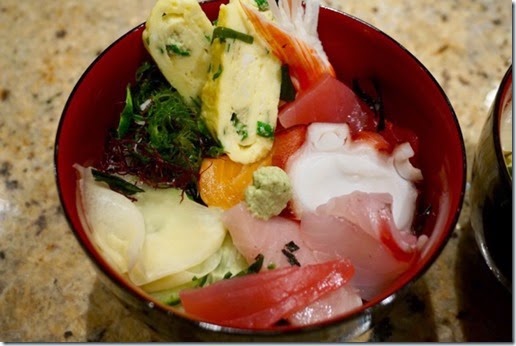
I covered the sushi rice with finely cut nori stripes and placed the assorted sashimi, cucumber slices, vinegared ginger root or "gari" ガリ and mixed sea weed salad on top. The sashimi items included, tuna, hamachi, rock fish, octopus, salmon and imitation crab.

Since we cooked the rice after we came home, we did not do anything special (like adding a sheet of kelp and sake). My wife just prepared rice using our "fuzzy logic" rice cooker (with slightly less water for sushi). I could have made sushi vinegar myself (by adding sugar and salt to rice vinegar), but I used a bottle of Mizukan Sushi vinegar ミツカン寿司酢. To allow the maximum absorption, I heated the sushi vinegar in the microwave (just warm). I used my small cedar sushi-oke 寿司桶 we brought from Kiso 木曽, Japan, some years ago (wood absorbs excess moisture from sushi rice). I added the cooked rice to the sushi-oke, poured the sushi vinegar on the rice (about 10% by weight but I usually add as much as the rice can absorb without getting wet). I let it stand for 5 minutes covered with a moist tea towel. I then mixed the rice with a bamboo rice paddle ("hera" へら) using a cutting motion while my wife fanned it with a Japanese paper fan we keep in the cupboard just for this purpose. The fanning cools the rice more quickly and helps evaporate the excess moisture. I then gathered the rice to one side to make a mound and cover it with the moist tea towel again to let it sit for several more minutes allowing the vinegar to absorb further. I put the sushi rice in a bowl, put on enough nori strips to cover the surface of the rice and then put on the toppings. For this dish, I placed real wasabi on the top. Just before serving I sprinkled sushi shouyu (special soy sauce for sashimi from the bottle).
The original combination sashimi looked like this.
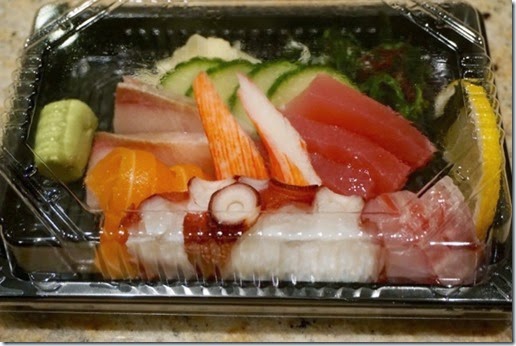
This is after taking off the lid.
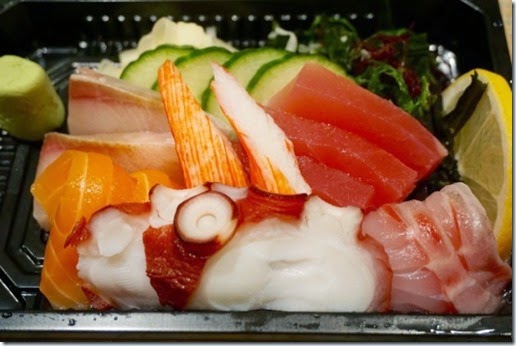
We got two orders but I decided that dividing one order was enough for both of us for nama-chirashi. The next day, I served the remaining order into two small appetizer sashimis as seen below.
The nama-chirashi was very satisfactory. Although I thought we made too much sushi rice, I served it all and it all disappeared to the last grain. The sushi rice was seasoned enough and the sashimi was good. The combination of sushi rice, nori, and sashimi is a mainstay that cannot go wrong.

I covered the sushi rice with finely cut nori stripes and placed the assorted sashimi, cucumber slices, vinegared ginger root or "gari" ガリ and mixed sea weed salad on top. The sashimi items included, tuna, hamachi, rock fish, octopus, salmon and imitation crab.

Since we cooked the rice after we came home, we did not do anything special (like adding a sheet of kelp and sake). My wife just prepared rice using our "fuzzy logic" rice cooker (with slightly less water for sushi). I could have made sushi vinegar myself (by adding sugar and salt to rice vinegar), but I used a bottle of Mizukan Sushi vinegar ミツカン寿司酢. To allow the maximum absorption, I heated the sushi vinegar in the microwave (just warm). I used my small cedar sushi-oke 寿司桶 we brought from Kiso 木曽, Japan, some years ago (wood absorbs excess moisture from sushi rice). I added the cooked rice to the sushi-oke, poured the sushi vinegar on the rice (about 10% by weight but I usually add as much as the rice can absorb without getting wet). I let it stand for 5 minutes covered with a moist tea towel. I then mixed the rice with a bamboo rice paddle ("hera" へら) using a cutting motion while my wife fanned it with a Japanese paper fan we keep in the cupboard just for this purpose. The fanning cools the rice more quickly and helps evaporate the excess moisture. I then gathered the rice to one side to make a mound and cover it with the moist tea towel again to let it sit for several more minutes allowing the vinegar to absorb further. I put the sushi rice in a bowl, put on enough nori strips to cover the surface of the rice and then put on the toppings. For this dish, I placed real wasabi on the top. Just before serving I sprinkled sushi shouyu (special soy sauce for sashimi from the bottle).
The original combination sashimi looked like this.

This is after taking off the lid.

We got two orders but I decided that dividing one order was enough for both of us for nama-chirashi. The next day, I served the remaining order into two small appetizer sashimis as seen below.
The nama-chirashi was very satisfactory. Although I thought we made too much sushi rice, I served it all and it all disappeared to the last grain. The sushi rice was seasoned enough and the sashimi was good. The combination of sushi rice, nori, and sashimi is a mainstay that cannot go wrong.
Tuesday, April 21, 2015
Take-out sushi and sashimi from Kanpai Sushi テイクアウト寿司
One Friday evening, I stopped by on the way home from work and picked up sushi and sashimi combo from Kanpai Sushi. It came in the usual plastic take-out sushi container. I decide to serve the sashimi and sushi separately by re-plating with additional garnishes. The cucumber slices, perilla leaves and pickled ginger were just transferred from the container.
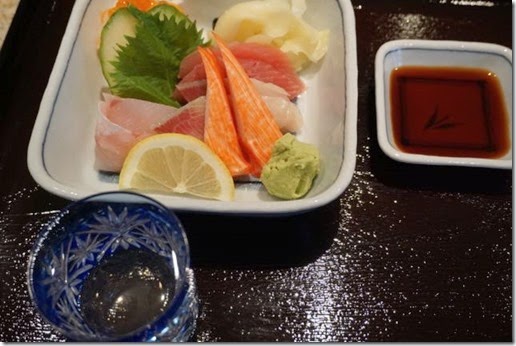
I added daikon namasu 大根なます and ikura いくら salmon roe. The sashimi included flounder, hamachi, tuna, and imitation crab. This was certainly good enough for a Friday evening. The pickled ginger was better than what we buy at the Japanese grocery store.
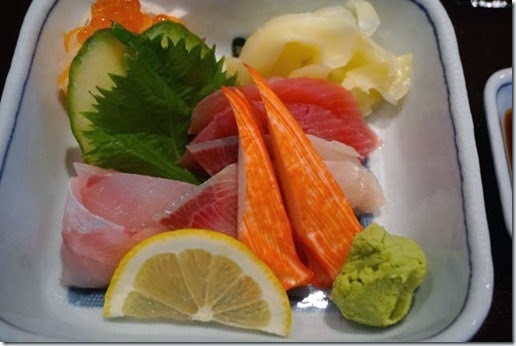
After few more dishes, we had the assorted sushi and rolls as an ending dish. The sushi items included tuna "tekka" roll 鉄火巻き, inari 稲荷. The nigiri are flounder, tuna and tamago. It also included a small sea weed salad which I enhanced by adding yuzu shoyu sauce.
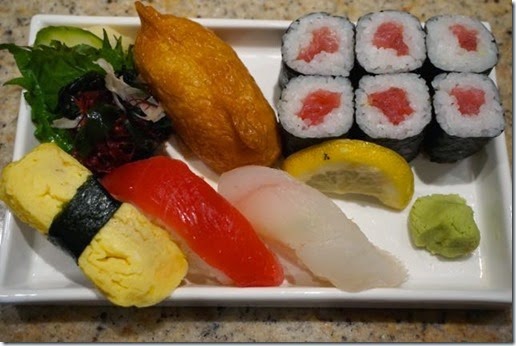
Certainly this is much better than take-out sushi you will find at the grocery stores even from the ones known for "gourmet" food. Compared to other sources of sashimi such as Catalina, with this take-out, we can have the amount we want with more variety and it is also so convenient.

I added daikon namasu 大根なます and ikura いくら salmon roe. The sashimi included flounder, hamachi, tuna, and imitation crab. This was certainly good enough for a Friday evening. The pickled ginger was better than what we buy at the Japanese grocery store.

After few more dishes, we had the assorted sushi and rolls as an ending dish. The sushi items included tuna "tekka" roll 鉄火巻き, inari 稲荷. The nigiri are flounder, tuna and tamago. It also included a small sea weed salad which I enhanced by adding yuzu shoyu sauce.

Certainly this is much better than take-out sushi you will find at the grocery stores even from the ones known for "gourmet" food. Compared to other sources of sashimi such as Catalina, with this take-out, we can have the amount we want with more variety and it is also so convenient.
Wednesday, September 24, 2014
Blue fin Tuna Block, sashimi, and sushi 本マグロの刺身と握り寿司
Nothing new here but we again got 1lb blue fin tuna block from Catalina. This block appears to have come from a larger fish than what we usually get. This time, I served sashimi from akami 赤身, toroトロ and karashi sumiso からし酢味噌 dressed “fat” and also as nigiri sushi 握り寿司.
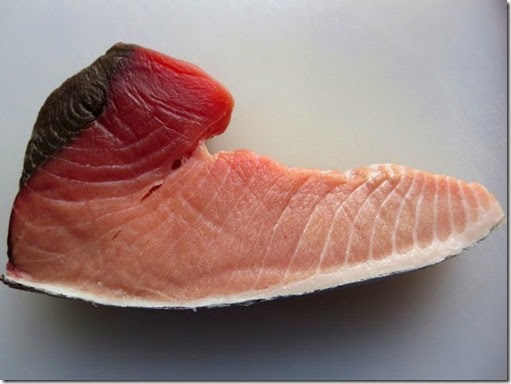
I first removed the skin. Under the otoro portion, you can see the thin but white fat layer. This layer is usually very firm and I do not want to leave it on the otoro piece. I try to keep this fat layer on the skin when removing it and then go back to the skin and shave off the layer of fat. I divided the tuna immediately into blocks of “chiai”, akami, and toro. I further divided the toro block into chutoto 中トロ and otoro 大トロ blocks. The portions I do not serve immediately, I wrap in kitchen parchment paper, place in a Ziploc bag and then put it in the meat drawer of the refrigerator. I usually marinade chiai and use it later for different dishes.
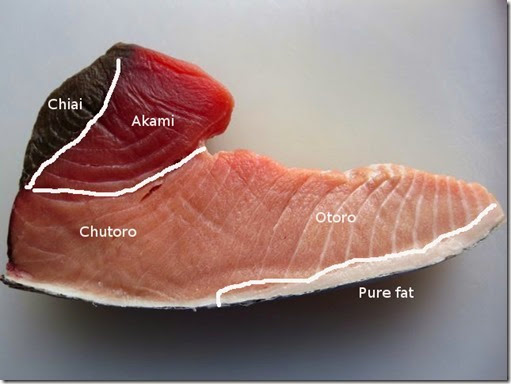
We also got spot prawn (ama-ebi 甘エビor more similar to botan ebi 牡丹エビ). Some were still alive (albeit barely) when we received them. I quickly iced them down (picture below). These prawn are very perishable. The best I can do is to ice them down while preparing. I remove the head and trim the antennae and proboscis. I set the small heads aside for deep frying by putting them in a sealable container with ice cubes. I put them in the meat drawer of the refrigerator (The ice will not melt completely for a few days in the meat drawer). The larger heads (and other shells), I immediately put in a pot with water to cook into a broth for miso soup, For the body, I remove the shell and devein it. I do this for only for the amount I’m going to serve. I place the rest with shell still on in a sealable container with ice cubes. With this treatment, these prawn will last for 2-3 days.
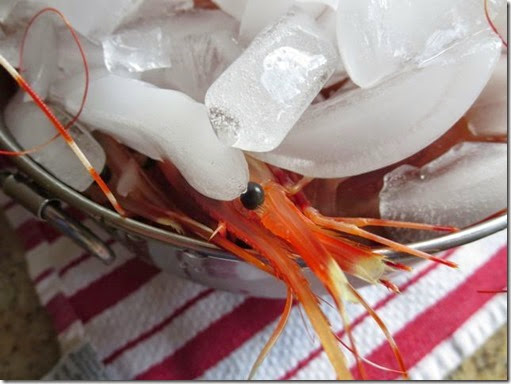
The picture below is actually the second evening serving after we received the fish. Instead of regular daikon garnish, I mixed daikon garnish with thinly sliced picked myouga 冥加 and dressed it in sweet vinegar. I seared the Otoro with a kitchen torch or “aburi” 炙り. I cut the Amaebi in half lengthwise and then sliced it obliquely (this was a rather large prawn).
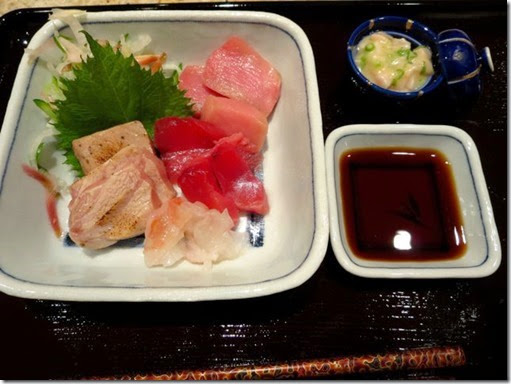
I cut the pure fat layer of the tuna into small cubes and dressed with karashi sumiso and finely chopped scallion.
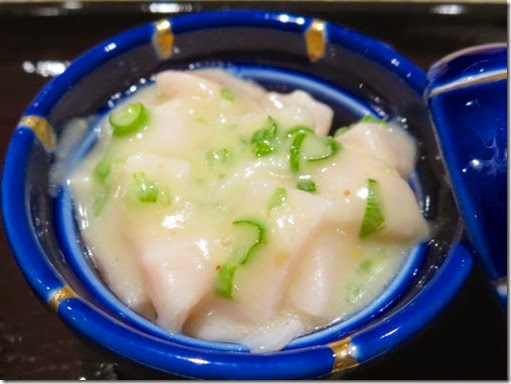
For a change, I attempted to make nigiri sushi as an ending dish. For sushi rice, I used koshihikaru コシヒカリ imported from Niigata prefecture. I used smaller prawns for sushi. Others are akami and chutoro. Wasabi was just thawed “real” wasabi.
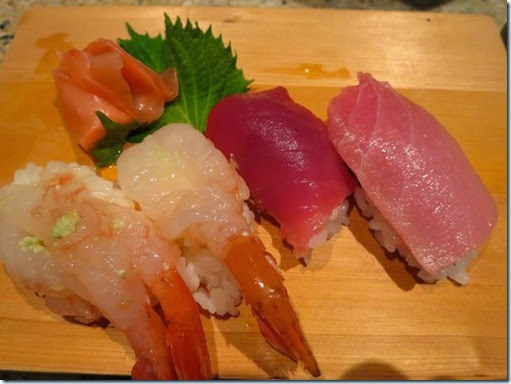
For my rare attempts at making nigiri, it was OK.
The sashimi was excellent. We really enjoyed this sushi and sashimi dinner.

I first removed the skin. Under the otoro portion, you can see the thin but white fat layer. This layer is usually very firm and I do not want to leave it on the otoro piece. I try to keep this fat layer on the skin when removing it and then go back to the skin and shave off the layer of fat. I divided the tuna immediately into blocks of “chiai”, akami, and toro. I further divided the toro block into chutoto 中トロ and otoro 大トロ blocks. The portions I do not serve immediately, I wrap in kitchen parchment paper, place in a Ziploc bag and then put it in the meat drawer of the refrigerator. I usually marinade chiai and use it later for different dishes.

We also got spot prawn (ama-ebi 甘エビor more similar to botan ebi 牡丹エビ). Some were still alive (albeit barely) when we received them. I quickly iced them down (picture below). These prawn are very perishable. The best I can do is to ice them down while preparing. I remove the head and trim the antennae and proboscis. I set the small heads aside for deep frying by putting them in a sealable container with ice cubes. I put them in the meat drawer of the refrigerator (The ice will not melt completely for a few days in the meat drawer). The larger heads (and other shells), I immediately put in a pot with water to cook into a broth for miso soup, For the body, I remove the shell and devein it. I do this for only for the amount I’m going to serve. I place the rest with shell still on in a sealable container with ice cubes. With this treatment, these prawn will last for 2-3 days.

The picture below is actually the second evening serving after we received the fish. Instead of regular daikon garnish, I mixed daikon garnish with thinly sliced picked myouga 冥加 and dressed it in sweet vinegar. I seared the Otoro with a kitchen torch or “aburi” 炙り. I cut the Amaebi in half lengthwise and then sliced it obliquely (this was a rather large prawn).

I cut the pure fat layer of the tuna into small cubes and dressed with karashi sumiso and finely chopped scallion.

For a change, I attempted to make nigiri sushi as an ending dish. For sushi rice, I used koshihikaru コシヒカリ imported from Niigata prefecture. I used smaller prawns for sushi. Others are akami and chutoro. Wasabi was just thawed “real” wasabi.

For my rare attempts at making nigiri, it was OK.
The sashimi was excellent. We really enjoyed this sushi and sashimi dinner.
Thursday, April 3, 2014
Party platters from Tako Grill タコグリルからのパーティープラター
On our last trip to Japan we, of course, visited my mother. We offered to take my mother and her two sisters (my aunts) out for lunch, but she said it was easier and more relaxing if we just stayed in and had the get-together at the house. My mother then produced a flyer she had just received from a chain sushi restaurant called "Kaisen-maru" 海鮮丸. Although she had not tried them before, she suggested that we order a sushi platter for our “aunts’ luncheon party. Just one phone call and a few hours later, a very polite and professional young man appeared at the front door with a large sushi platter and an order of chawanmushi 茶碗蒸し(still warm). (The choice of '”side” was miso soup or chawanmushi). He collected the money (a very reasonable price) and said "please leave the empty sushi-oke and bowls outside the front door when you finish". He added that he would come back later and collect them; which he did--they quietly disappeared soon after we put them out. The degree of service was just amazing (the sushi came in real "sushi-oke" 寿司桶 not a disposable plastic plate and the chawanmushi came in real porcelain bowls). My mother made miso soup using baby clams which happened to be one of my Aunt’s absolute favorite. The quality of sushi was pretty good considering it was a delivery from a chain sushi restaurant. We had a quite a feast and a very relaxing good time.
March is a busy birthday month for us with 3 to celebrate including our best friends. Using the Aunt’s party as a prototype my wife suggested we order a sushi platter from our Tako Grill for a “March Birthday” party. To “increase my enjoyment and relaxation” my wife forbade me from cooking for the occasion. So we ordered a sushi platter from Tako Grill.

Since one of the guests was a vegetarian, I asked Mr Segawa of Tako Grill to include more vegetable rolls than usual.

It was very nicely presented and even the "gari" ginger was arranged like a yellow rose. California roll in the front and "kankyou" maki かんぴょう巻き (vegetarian) in the back (above picture).

As you can see, sushi included tuna, yellow tail, flounder, eel, mackerel, salmon roe, California roll and few interesting vegetarian rolls. In addition to the sushi platter, we also asked Mr. Segawa to prepare Japanese-style appetizers.

The above is konnyaku dengaku (vegetarian) こんにゃくの田楽; the darker one are with peanuts sauce and the lighter ones (right) is more traditional miso sauce.

In the back, these are very nice and crispy chicken kara-age 鳥の唐揚げ, the front right are pork and onion kushiage 串揚げ and the front left are grilled marinated cubed steak サイコロステーキの串焼き. Mr Segawa also gave us asparagus dressed in tofu dressing (vegetarian) アスパラの白和え, which I forgot to take a picture.
As a desert, my wife ordered a dozen cupcakes on the internet from Georgetown Cupcake for pick-up at the Bethesda store. I am not sure why cupcakes are so popular now-a-days but Georgetown cupcake appears to have started this trend. My wife said she has even seen a pink truck labeled Curb-side cupcakes selling cupcakes in downtown DC and people line up on the side walk to buy them. When we arrived at the store for pick-up, the line extended out of the store and half-way down the block. This was despite a very heavy rain.

Everything was wonderful. The chicken, pork and steak were flavorful—the chicken especially crispy. The vegetarian rolls were creative and plentiful. Even the non-vegetarians were satisfied. We all had a wonderful time and was indeed the best birthday party ever.
Disclaimer: Although Tako Grill has its party platters including sushi, rolls, and appetizers, the platter shown here included some personal modifications Mr. Segawa made for us that may not be available on the usual menu.
March is a busy birthday month for us with 3 to celebrate including our best friends. Using the Aunt’s party as a prototype my wife suggested we order a sushi platter from our Tako Grill for a “March Birthday” party. To “increase my enjoyment and relaxation” my wife forbade me from cooking for the occasion. So we ordered a sushi platter from Tako Grill.

Since one of the guests was a vegetarian, I asked Mr Segawa of Tako Grill to include more vegetable rolls than usual.

It was very nicely presented and even the "gari" ginger was arranged like a yellow rose. California roll in the front and "kankyou" maki かんぴょう巻き (vegetarian) in the back (above picture).

As you can see, sushi included tuna, yellow tail, flounder, eel, mackerel, salmon roe, California roll and few interesting vegetarian rolls. In addition to the sushi platter, we also asked Mr. Segawa to prepare Japanese-style appetizers.

The above is konnyaku dengaku (vegetarian) こんにゃくの田楽; the darker one are with peanuts sauce and the lighter ones (right) is more traditional miso sauce.

In the back, these are very nice and crispy chicken kara-age 鳥の唐揚げ, the front right are pork and onion kushiage 串揚げ and the front left are grilled marinated cubed steak サイコロステーキの串焼き. Mr Segawa also gave us asparagus dressed in tofu dressing (vegetarian) アスパラの白和え, which I forgot to take a picture.
As a desert, my wife ordered a dozen cupcakes on the internet from Georgetown Cupcake for pick-up at the Bethesda store. I am not sure why cupcakes are so popular now-a-days but Georgetown cupcake appears to have started this trend. My wife said she has even seen a pink truck labeled Curb-side cupcakes selling cupcakes in downtown DC and people line up on the side walk to buy them. When we arrived at the store for pick-up, the line extended out of the store and half-way down the block. This was despite a very heavy rain.

Everything was wonderful. The chicken, pork and steak were flavorful—the chicken especially crispy. The vegetarian rolls were creative and plentiful. Even the non-vegetarians were satisfied. We all had a wonderful time and was indeed the best birthday party ever.
Disclaimer: Although Tako Grill has its party platters including sushi, rolls, and appetizers, the platter shown here included some personal modifications Mr. Segawa made for us that may not be available on the usual menu.
Subscribe to:
Posts (Atom)















